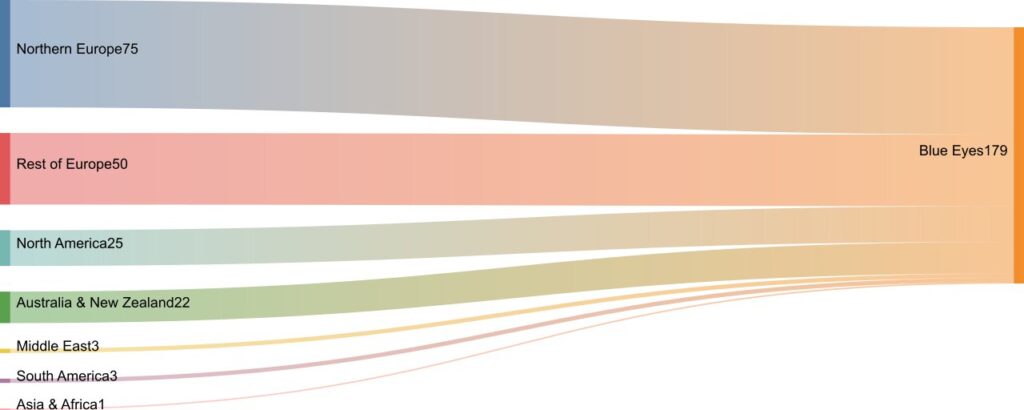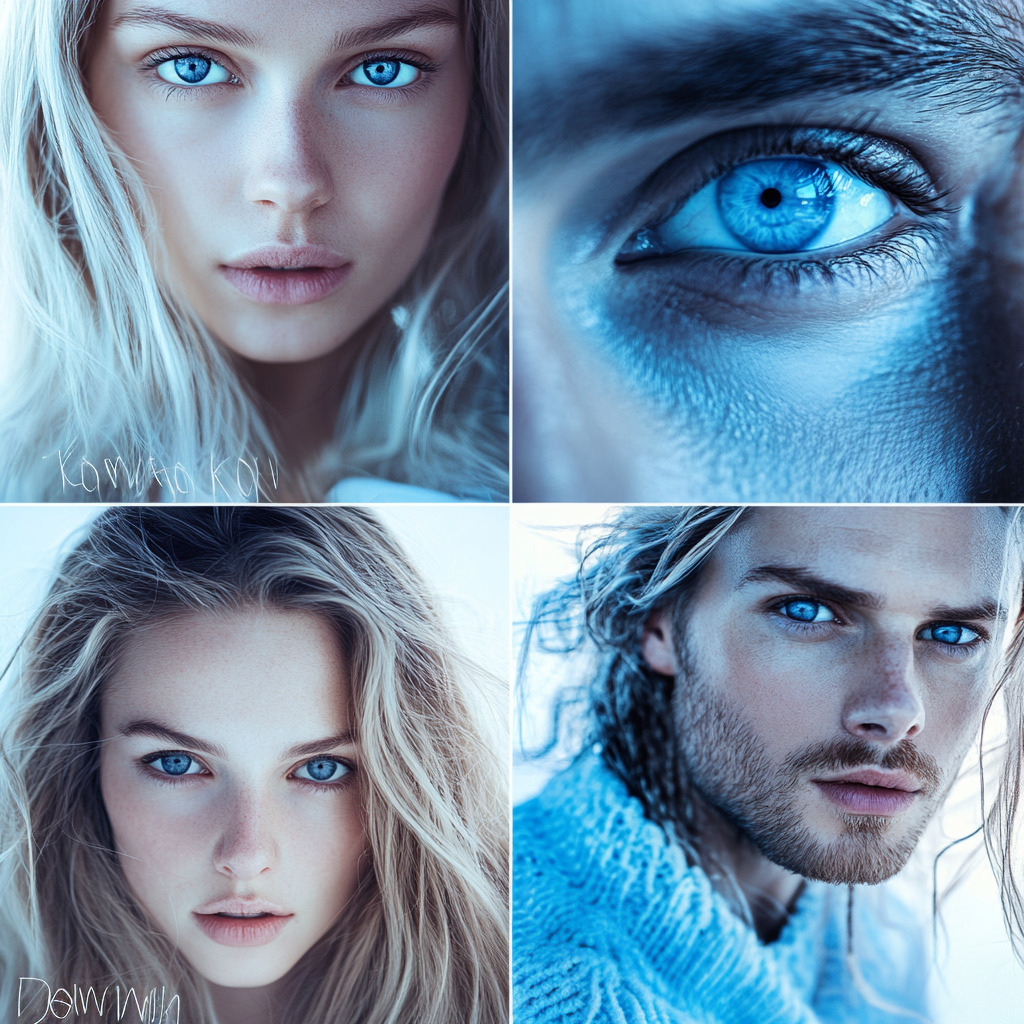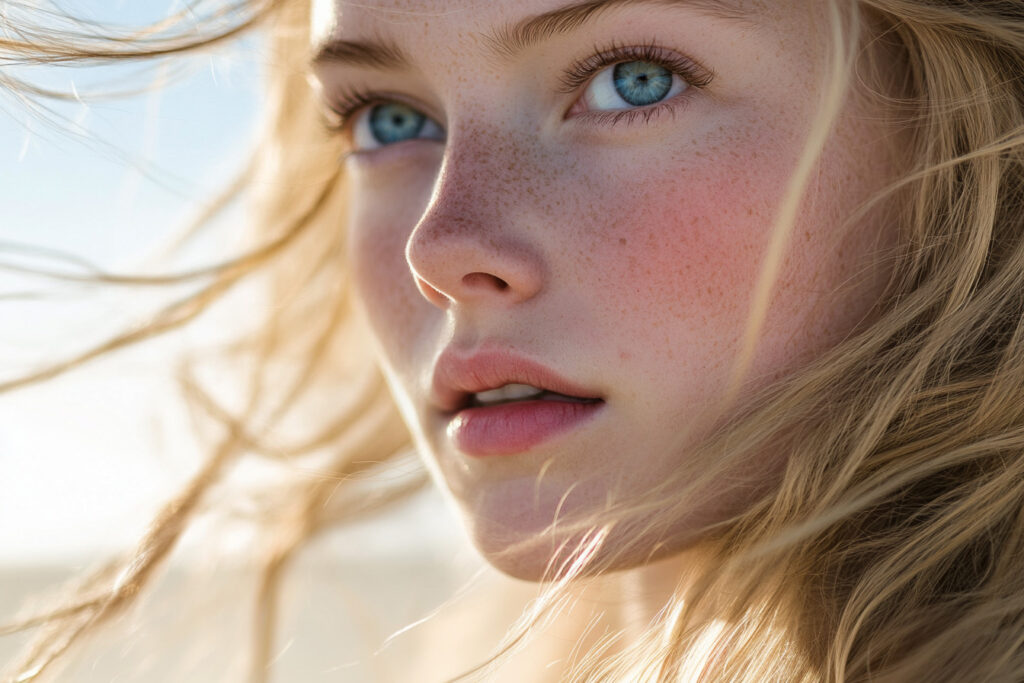The Magic of Blue Eyes
This hue has long been associated with mystery, depth, and elegance. Its unique appearance results from light scattering within the iris rather than actual pigmentation. This effect, known as Rayleigh scattering, is the same phenomenon that makes the sky appear blue. Depending on lighting and surroundings, the color can shift from a soft, icy tone to a deep, oceanic shade.
With only 8–10% of the world’s population having this eye color, it remains one of the rarest and most admired. From genetic origins to cultural significance, this trait continues to fascinate scientists and storytellers alike. Whether bright and piercing or soft and dreamy, every pair tells a unique story.
| Topic | Key Points |
|---|---|
| Definition of Blue Eyes | Light-colored eyes with shades ranging from icy blue to deep sapphire; appear to change slightly with lighting. |
| Genetics of Blue Eyes | Result from low melanin levels in the iris, influenced by genetic variations. |
| Global Rarity | Found in about 8–10% of the world’s population. |
| Cultural Significance | Often associated with beauty, depth, and intensity; historically linked to uniqueness and fascination. |
| Makeup Tips | Colors like silver, gray, bronze, and warm brown tones enhance blue eyes. |
| Celebrities with Blue Eyes | Chris Hemsworth, Taylor Swift, Brad Pitt, Margot Robbie. |
| Eye Care & Health | Blue eyes are more sensitive to sunlight due to lower melanin; UV protection is essential. |
What Are Blue Eyes?
This cool-toned shade is known for its icy and deep sapphire hues. Unlike darker eyes, it contains very little melanin, which allows light to scatter within the iris, creating its signature appearance. This phenomenon, known as the Tyndall effect, is the same reason why the sky appears blue.
While some shades may appear lighter or darker depending on lighting and surroundings, all variations share the same trait: low melanin levels. This makes them more sensitive to sunlight and gives them their striking, luminous quality.
How They Differ from Other Eye Colors
- Compared to brown eyes → Brown has high melanin levels, making it darker and offering better sunlight protection, while this shade appears lighter and more sensitive.
- Compared to green eyes → Green contains more melanin, giving it a slightly golden or hazel-like appearance, whereas this shade remains purely cool-toned.
- Compared to gray eyes → Gray has a more muted, silvery tone due to additional collagen in the iris, creating a softer, misty effect.
The Genetics of Blue Eyes
This eye color is determined by genetics and the distribution of melanin in the iris. Unlike brown or green eyes, it contains very little melanin, causing light to scatter and create its signature hue—known as the Rayleigh scattering effect (the same process that makes the sky appear blue).
Early theories suggested a simple dominant-recessive inheritance, but modern research shows that multiple genes influence eye color,
making it more complex.
The Role of Melanin in Blue Eyes
Melanin levels in the stroma of the iris determine eye color:
- Brown eyes → High melanin, absorbing more light.
- Green eyes → Moderate melanin, creating a mix of golden-green hues.
- Blue eyes → Minimal melanin, causing light scattering.
- Gray eyes → Similar to blue but with more collagen, giving a silvery tone.
Since this eye color has the least melanin, its shade may appear to shift slightly depending on lighting and surroundings.
Which Genes Influence Eye Color?
The OCA2 and HERC2 genes, located on chromosome 15, play a key role in determining this trait. These genes regulate melanin production in the iris. Because there is very little melanin, light scattering creates the signature appearance. Other genetic factors also contribute, which is why this trait can appear in families even if neither parent has it.
Can This Eye Color Be Passed Down?
Yes! This trait is inherited, but since multiple genes influence eye color, two parents with brown, green, or hazel eyes can still have a child with this shade if the right genetic combination occurs. However, because this eye color results from low melanin levels, it is typically recessive and less common worldwide.
Prevalence and Distribution of Blue Eyes
This relatively rare eye color accounts for approximately 8–10% of the global population. Its occurrence is influenced by genetic heritage and geographic location with the highest concentration found in Northern and Eastern Europe. While more common than green eyes, it remains uncommon and is often admired for its striking appearance and light-reflecting properties.
How Common Are Blue Eyes Worldwide?
The prevalence of this trait varies by region:

Why Are Blue Eyes More Common in Some Regions?
- European genetic influence → Blue eyes are most prevalent in people with European ancestry, particularly in Northern and Eastern Europe, where genetic diversity in eye color is highest.
- Migration & genetic mixing → Countries with significant European migration (such as North America, Australia, and parts of South America) tend to have a higher percentage of people with blue eyes.
- Melanin & climate adaptation → In regions with low sunlight exposure, lighter eyes (including blue) are more common due to lower melanin levels. This adaptation allows for better light absorption in dim environments, while darker eyes dominate in sunnier climates for UV protection.
Significance of Blue Eyes
This rare eye color has long been associated with mystery and intelligence. Its rarity in certain regions has led to cultural myths and personality stereotypes, often portraying individuals with this trait as having a captivating gaze. While there is no scientific link between eye color and personality, societal beliefs continue to shape how it is perceived across different cultures.
Blue Eyes in Different Cultures
- European folklore → In some traditions, it symbolized wisdom and a connection to the supernatural.
- Nordic and Baltic influence → Extremely common in Scandinavia and the Baltic region, considered a sign of heritage.
- Western beauty standards → Romanticized in Hollywood and media as a symbol of charm and innocence.
- Middle Eastern and South Asian perspectives → Seen as exotic and striking due to its rarity.
- African and Indigenous symbolism → In regions where it is highly uncommon, sometimes viewed as mystical in folklore.

Styling Tips for Blue Eyes: Makeup, Glasses, and Clothing
This striking and captivating eye color can be enhanced with the right makeup, glasses, and clothing choices. Selecting complementary shades can make the eyes appear brighter, deeper, or more vibrant. Warm tones like bronze and copper create contrast, while cool tones like silver and navy accentuate the natural icy hue. More style tips
Makeup Tips for Blue Eyes
The right eyeshadow can enhance different shades within the iris.
Best Eyeshadow Colors
| Eyeshadow Color | Effect |
|---|---|
| Copper & Warm Bronze | Enhances contrast, making the color appear brighter. |
| Peach & Coral | Adds warmth, making the shade stand out vividly. |
| Navy & Deep Blue | Deepens natural tones for a striking effect. |
| Silver & Cool Gray | Accentuates icy tones, giving a radiant glow. |
| Soft Lavender & Lilac | Creates a dreamy look, complementing cool hues. |
✔ Pro Tip: Use warm-toned shades like copper and peach for contrast, or navy eyeliner to enhance depth without overpowering softness.
Best Eyeliner & Mascara Colors
- Warm brown or copper eyeliner → Softer than black, enhancing cool tones.
- Navy or charcoal eyeliner → Adds depth without harsh contrast.
- Black mascara → Classic and bold, making the color stand out.
- Dark brown or plum mascara → A softer, natural option for warmth.
Best Highlighter & Blush Shades
- Champagne or pearl highlighter → Enhances natural shimmer.
- Peach or soft pink blush → Adds warmth without overpowering brightness.
Best Glasses for Blue Eyes
The right frame color can enhance natural tones.
| Frame Color | Effect |
|---|---|
| Tortoiseshell | A warm, classic contrast. |
| Deep Blue or Navy | Enhances natural depth. |
| Silver or Cool Gray | Complements cool undertones, making them appear brighter. |
| Rose Gold or Soft Pink | Adds warmth for a balanced, elegant look. |
| Dark Brown or Espresso | Provides a subtle, sophisticated frame. |
✔ Pro Tip: Avoid bright orange or yellow frames, as they may overpower cool tones.
Best Clothing Colors
Wardrobe choices can enhance vibrancy and depth.
| Clothing Color | Effect |
|---|---|
| Deep Blue & Navy | Intensifies depth, making them more vibrant. |
| Cool Grays & Silvers | Complements blue tones for a sophisticated look. |
| Soft Lavender & Lilac | Enhances icy, bright qualities. |
| Rich Burgundy & Deep Red | Creates bold contrast, making the eyes stand out. |
| Earthy Tones (Beige, Taupe, Chocolate) | Provides a natural balance. |
✔ Pro Tip: Avoid mustard or bright green, as they may clash with cool undertones.
Final Styling Tips
✔ Use cool-toned makeup like silver, navy, and lavender to enhance brightness.
✔ Choose cool or neutral-toned glasses for a complementary effect.
✔ Wear rich blues, grays, and deep reds to highlight vibrancy.
✔ Avoid overly warm shades in makeup, frames, and clothing to prevent clashing.
Celebrities with Blue Eyes
Blue eyes have long been associated with charm, intensity, and a mesmerizing gaze, making them a standout feature among many celebrities.
Whether icy light or deep oceanic, it enhances on-screen presence and leaves a lasting impression. Here are some well-known personalities with this standout feature:
Famous Women with Blue Eyes
- Margot Robbie – Her piercing gaze adds to her stunning and elegant look.
- Taylor Swift – Bright, unforgettable eyes often accentuated with makeup.
- Jennifer Aniston – Radiant tones that complement her warm complexion.
- Cameron Diaz – Crystal-clear shade that enhances her playful presence.
- Reese Witherspoon – Deep, expressive color that gives her a soft yet powerful look.

Famous Men with Blue Eyes
- Chris Evans – Steely gaze that adds to his strong, heroic persona.
- Leonardo DiCaprio – Expressive eyes that have captivated audiences for decades.
- Brad Pitt – Signature look contributing to his timeless charm.
- Zac Efron – Vibrant shade that enhances his charismatic appeal.
- Daniel Craig – Intense gaze, perfectly fitting for James Bond.
Eye Care and Health Considerations for Blue Eyes
Having blue eyes is not just about aesthetics—eye color can also play a role in light sensitivity and overall eye health. Since blue eyes contain low amounts of melanin, they offer less natural protection against bright light and UV exposure, making them more sensitive to sunlight. Here’s what you need to know about taking care of your blue eyes.
Are Blue Eyes More Sensitive to Light?
Yes, blue eyes tend to be more light-sensitive than darker eye colors due to lower melanin levels:
- Brown eyes → High melanin, offering strong UV protection.
- Hazel eyes → Moderate melanin, providing some UV protection but still vulnerable to bright light.
- Blue/Green eyes → Low melanin, making them the most sensitive to sunlight and glare.
People with blue or lighter-colored eyes may experience higher glare sensitivity, especially in bright sunlight or when driving at night.
How to Protect Blue Eyes from UV Damage
Since blue eyes are highly susceptible to UV rays, it’s essential to protect them properly:
✓ Wear sunglasses with 100% UV protection → Look for lenses that block both UVA and UVB rays.
✓ Use polarized lenses → Reduce glare, especially helpful for driving or outdoor activities.
✓ Limit direct sunlight exposure → Wearing a hat or seeking shade can help reduce UV damage.
✓ Use artificial tears → If your eyes feel dry due to sun or screen exposure, hydrating eye drops can help.
Common Eye Conditions Linked to Blue Eyes
While blue eyes do not cause specific health problems, they may have higher risks for certain conditions due to low melanin levels:
| Eye Condition | Risk Factor for Blue Eyes | Prevention Tips |
|---|---|---|
| Photophobia (Light Sensitivity) | High risk due to low melanin levels. | Wear sunglasses and avoid bright artificial lights. |
| Cataracts (Age-Related Clouding of the Eye) | Increased risk due to prolonged UV exposure. | Use UV-blocking sunglasses and get regular eye exams. |
| Macular Degeneration | Higher risk with extended UV exposure. | Eat a diet rich in omega-3s and antioxidants. |
| Dry Eyes (Screen Fatigue) | Common with prolonged screen exposure. | Follow the 20-20-20 rule: Every 20 minutes, look 20 feet away for 20 seconds. |
By taking the right precautions, you can keep your blue eyes healthy and well-protected!
Best Diet for Healthy Blue Eyes
Eating a nutrient-rich diet can help protect your vision and maintain eye health. Key nutrients include:
✔ Vitamin A (Carrots, sweet potatoes, spinach) → Supports night vision and overall eye health.
✔ Lutein & Zeaxanthin (Kale, eggs, oranges) → Help protect the retina from damage.
✔ Omega-3 Fatty Acids (Salmon, flaxseeds, walnuts) → Reduce dry eye symptoms and inflammation.
✔ Vitamin C & E (Citrus fruits, almonds, sunflower seeds) → Antioxidants that protect against cataracts.
Final Eye Care Tips for Blue Eyes
✅ Get regular eye exams to detect any issues early.
✅ Use blue light filters when spending long hours on screens.
✅ Blink frequently to prevent dry eyes, especially when reading or working on a computer.
✅ Avoid rubbing your eyes, as this can cause irritation and increase the risk of infections.
By maintaining a healthy diet and proper eye care, you can keep your blue eyes vibrant and protected!
FAQs About Blue Eyes
1. Why do blue eyes sometimes appear lighter or darker?
Blue eyes can look different depending on lighting, clothing, and even mood. This is because blue eyes contain very little melanin, and their color comes from how light is scattered in the iris rather than actual pigment.
2. Can blue eyes change over time?
Slightly, yes. Many babies are born with blue eyes, but as they grow, melanin may develop, making their eyes darker. In adulthood, blue eyes remain stable, with any changes usually due to lighting and surroundings rather than actual pigment changes.
3. Are people with blue eyes more sensitive to light?
Yes. Blue eyes have low melanin levels, meaning they provide less natural protection against bright light. This makes people with blue eyes more prone to glare sensitivity and discomfort in bright sunlight. Wearing UV-protective sunglasses can help reduce strain.
4. Do blue eyes have any health advantages or risks?
While blue eyes are often admired for their beauty, they are more susceptible to UV damage, increasing the risk of cataracts and macular degeneration over time. Regular eye exams and proper UV protection are essential for long-term eye health.
5. Can two parents without blue eyes have a blue-eyed child?
Yes! Eye color is determined by multiple genes, so even if both parents have brown or green eyes, they can still carry recessive genes for blue eyes, leading to a blue-eyed child.
6. Are blue eyes rarer than green eyes?
No, but they are still quite rare. Blue eyes occur in about 8–10% of the world’s population, whereas green eyes are the rarest, found in only 2% of people worldwide.
7. Can blue eyes turn brown or green permanently?
No. Once a person reaches adulthood, eye color does not change permanently. However, lighting, makeup, and clothing choices can enhance or alter the appearance of blue eyes, making them seem lighter or darker.
8. What is the best way to enhance blue eyes naturally?
Wearing cool-toned clothing like navy, silver, or lavender, using bronze or peach-toned makeup, and choosing glasses with silver, gray, or tortoiseshell frames can make blue eyes stand out beautifully.

